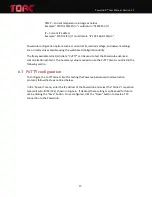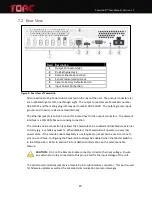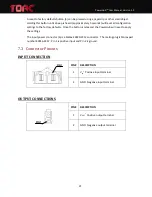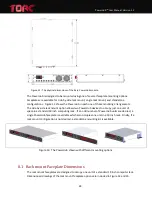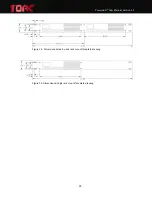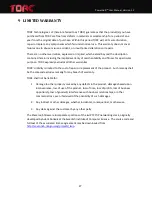
PowerHub
TM
User Manual, Version 1.2
16
6
ADVANCED COMMUNICATION PROTOCOL
In addition to the web interface, the PowerHub also accepts ASCII commands over TCP
(firmware v1.1 and above). The commands are made up of a command word and one or more
arguments separated by spaces. A carriage return (0x0D) followed by a new line (0x0A) denotes
the end of each complete command and terminates each response. Only NVT ASCII characters
are valid, and any telnet option requests will trigger a WONT or DONT response (See RFC 854 for
details). This permits the use of either a standard telnet client or a raw TCP connection to port
23.
The serial port may also be used for sending and receiving advanced communications protocol
messages (firmware v1.2 and above). It is configured for 115200 baud, 8 data bits, no parity, 1
stop bit, and no flow control.
The following commands are available:
ON
- Switches an output to the
ON
state.
Usage: “ON <output numbers, separated by spaces>\r\n”
Example: “ON ALL\r\n” will turn all outputs on
Example: “ON 1 8 4\r\n” will turn outputs 1, 8, and 4 on.
OFF
- Switches an output to the
OFF
state
Usage: “OFF <output numbers, separated by spaces>\r\n”
Example: “OFF ALL” will turn all outputs off
Example: “OFF 1 5 3\r\n” will turn outputs 1, 5, and 3 off.
STATUS
- Displays system status
Usage: “STATUS <option>\r\n”
Options:
OUT – Current output state
Example: “STATUS OUT\r\n”
could return “OUT ON OFF OFF ERR ON ON OFF OFF\r\n”
IOUT – Current output amperes
Example: “STATUS IOUT\r\n”
could return “IOUT 1.2 0.0 0.0 0.0 8.5 0.1 0.0 0.0\r\n”
VOUT – Current output voltage
Example: “STATUS VOUT\r\n” could return “VOUT 13.8\r\n”
VIN – Current input voltage.
Example: “STATUS VIN\r\n” could return “VIN 55.0\r\n”
FAN – Current fan state
Example: “STATUS FAN\r\n” could return “FAN OK\r\n” or “FAN ERR\r\n”
















